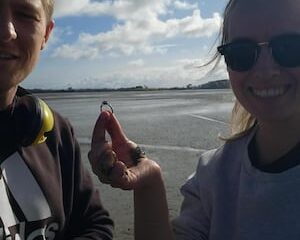Business
New Zealand Sharemarket Declines Despite Strong Global Performance

New Zealand’s sharemarket experienced a decline on October 20, 2023, closing down despite robust performances in both the United States and Australia. The S&P/NZX 50 Index fell by 25 points, or 0.19%, finishing the day at 12,880.40. Trading volume reached 39.8 million shares, valued at approximately $160.99 million. On the main board, there were 81 stocks that rose while 58 fell.
The US markets, in contrast, continued to advance, setting new records. The Nasdaq surged by 153.78 points, or 0.7%, to close at 20,884.27, while the S&P 500 gained 33.66 points, or 0.5%, reaching 6,297.36. This divergence highlights a notable disconnect between New Zealand’s market and its larger counterparts in the US and Australia.
Investor sentiment in New Zealand appeared cautious, as the day was characterized by relatively low trading activity. The market’s overall performance did not align with the optimism seen in global markets. Analysts suggest that local factors may be influencing investor decisions, contributing to the weaker closing numbers.
In the US, the positive momentum was driven by strong earnings reports and encouraging economic data, which have bolstered confidence among investors. The Nasdaq’s record high reflects a growing interest in technology stocks, while the S&P 500’s performance indicates broad-based gains across various sectors.
New Zealand’s market dynamics may require closer examination as investors navigate the current climate. While the S&P/NZX 50 Index has faced challenges, the overall economic outlook remains a topic of discussion among financial analysts. The divergence between New Zealand’s performance and the stronger gains in the US and Australian markets raises questions about the local economy’s resilience and future trajectory.
As the week progresses, market participants will be keenly observing developments that may influence trading patterns. The next trading days will reveal whether New Zealand’s sharemarket can recover or if it will continue to lag behind its counterparts abroad.
Business
Electricity Authority Streamlines National Grid Connections

The Electricity Authority has announced significant changes aimed at simplifying and expediting the process for connecting to New Zealand’s national electricity grid. This initiative is designed to reduce both costs and time for businesses seeking to connect infrastructure, including public electric vehicle (EV) charging stations, manufacturing facilities, and solar farms.
The authority’s general manager, Tim Sparks, emphasized that the new measures will standardize connection rules across the country’s 29 lines companies. “Inconsistencies and inefficiencies in the application processes and pricing methodologies can add unnecessary time and cost to projects, particularly for those who want to operate in multiple regions,” Sparks stated.
Under the revised guidelines, lines companies will be required to provide the least-cost, technically acceptable solutions for connections. This approach aims to ensure that businesses are not burdened with costs for network improvements they did not request. “Any extra costs, such as running a connection underground, will be the responsibility of the party requesting it,” Sparks explained, highlighting a commitment to fair pricing.
Key Changes to Connection Processes
The Electricity Authority’s changes also target larger users, including operators of EV charge points and public transport services. These adjustments include new timeframes for decision-making, which previously lacked baseline protections for significant energy users. “To date, large energy users haven’t had baseline protections because the rules have only applied to electricity generators directly connecting to the network,” Sparks noted.
The updated framework is expected to enhance transparency and certainty for all stakeholders involved in the connection process. Sparks is optimistic that providing a clear and consistent procedure will make it more efficient for everyone involved.
The majority of the requirements concerning new connection pricing are set to take effect on 1 April 2026. This timing aligns with other distribution pricing changes and processes established by the Commerce Commission. Meanwhile, the new connection application procedures will be implemented in the second half of 2026.
The Electricity Authority’s initiative represents a proactive step toward modernizing the electricity network, ensuring that New Zealand can meet the growing demand for reliable and efficient energy solutions. As businesses prepare for these changes, the focus remains on creating an environment that fosters innovation and sustainability in the energy sector.
Business
Kinterra and CAML Compete with Rival Bids for New World Resources

Private equity firm Kinterra Capital and London-listed Central Asia Metals (CAML) have intensified their competition for control of New World Resources, an Australian Securities Exchange (ASX)-listed company with significant assets in the United States. Both firms have raised their offers to New World shareholders, seeking to secure a takeover of the company that is developing the promising Antler copper deposit in Arizona.
On July 17, 2023, CAML submitted a revised bidder’s statement, increasing its offer to A$0.065 per share, up from its earlier bid of A$0.05 announced in May and a subsequent offer of A$0.062 made on July 7. In response to this updated proposal, New World’s board of directors unanimously recommended that shareholders accept CAML’s offer, provided no superior proposals emerge. The board also advised shareholders to refrain from taking any action regarding Kinterra’s previous bid of A$0.064 per share, made on July 10.
Shortly after CAML’s announcement, New World confirmed a new offer from Kinterra at A$0.066 per share. This offer includes a provision for an increased price of A$0.067 if Kinterra’s relevant interest in New World surpasses 30% by 17:00 AEST on July 24. In accordance with a matching rights regime, New World issued a notice to CAML, granting the company five business days to match Kinterra’s higher bid. Nevertheless, New World’s board continues to recommend the CAML offer and has urged shareholders to withhold action on Kinterra’s proposal for now.
Earlier this month, Kinterra lodged a complaint with the Australian Takeovers Panel, alleging that New World and CAML had engaged in actions that could undermine a competitive bidding process.
New World Resources is currently focused on developing the Antler copper deposit, which Managing Director and CEO Nick Woolrych described in May as one of the highest-grade copper projects globally. The company plans to commence construction on the project later this year, with production expected to begin in 2027 for copper, zinc, and gold. The rising demand for copper, identified as a critical mineral, is further fueled by a recent announcement from the U.S. government imposing a 50% tariff on copper imports, which is anticipated to increase internal demand for copper resources.
As the bidding war escalates between Kinterra and CAML, the outcome will not only impact the companies involved but also shape the future of New World Resources and its development plans in Arizona.
Business
University Students Face Legal Risks for Promoting Gambling Sites

University students in New Zealand have received warnings from the Department of Internal Affairs regarding their promotion of overseas gambling websites on social media. This action follows the identification of ten students, primarily from the universities of Otago and Canterbury, who were found endorsing sites such as Rainbet and SpinBet in exchange for financial incentives.
The crackdown on this practice comes after internet personality Millie Elder-Holmes was fined $5,000 in May for similar promotional activities. Investigations revealed that numerous Instagram accounts, boasting thousands of followers, featured students posting videos of themselves wagering significant sums of money on these offshore platforms. Many posts included links, logos, or referral codes urging viewers to register with these gambling sites. Some students openly discussed their motivations for gambling, citing expenses like parking fines, petrol, and even student loan payments, which often totalled around $300.
In an effort to address these concerns, Vicki Scott, director of gambling regulatory services at the Department of Internal Affairs, noted that the department is actively investigating complaints related to these promotions. “The students we’ve spoken to have been co-operative, and several have taken immediate steps to remove the content,” Scott remarked. She emphasized the seriousness of the situation, stating, “Promoting overseas gambling websites is illegal and can result in a $5,000 infringement fine.”
While online gambling is legal for New Zealanders, advertising these platforms within the country remains prohibited. Andrée Froude, director of advocacy and public health at the Problem Gambling Foundation, expressed concerns about the use of social media to bypass this advertising ban. She cited past instances, such as when Brendon McCullum was used to promote the site 22Bet, prompting Google to intervene and remove the ads.
The involvement of university students in promoting online gambling raises alarms, particularly as they are often financially vulnerable. “They are targeting young students who might not have a lot of extra money to spend,” Froude stated, deeming the situation “appalling.”
Attempts to gather responses from Rainbet and SpinBet were unsuccessful prior to publication.
Government Response and Future Regulations
The New Zealand government is preparing to implement a licensing regime for online gambling, which would allow up to 15 online casinos, including some offshore companies, to operate legally within the country. Companies that fail to secure a license could face fines of up to $5 million. Brooke van Velden, the Internal Affairs Minister, acknowledged the issue, stating, “I am aware of cases of people, who appear to be university students, promoting online casino gambling through their social media accounts.”
She indicated that the department is investigating these cases and may impose penalties, including formal warnings or fines, as deemed appropriate.
Concerns have also been voiced by Francisco Hernandez, the Green Party’s tertiary education spokesperson. He warned that the introduction of overseas casino licenses could lead to an increase in gambling among New Zealanders. “There is a risk legislation like that could end up mainstreaming the idea of online gambling,” he stated, emphasizing the necessity for local operators who comply with regulations to ensure responsible gambling practices.
According to research from the AUT gambling and addictions research centre, led by Maria Bellringer, the new legislation will permit offshore operators to legally advertise in New Zealand for the first time. The most recent New Zealand Gaming Survey revealed that individuals aged 15 to 24, predominantly males, are the most likely demographic to engage with online casinos. “I imagine the harms are going to increase and particularly to our young people,” Bellringer cautioned.
As online gambling becomes more accessible, the potential for harm among young people—who are typically more exposed to the internet and gaming—is a significant concern. The prevalence of these gambling sites poses a risk, as they often target financially vulnerable individuals with appealing marketing strategies. The implications of this trend could result in increased gambling-related issues across the country.
As discussions surrounding the regulation of online gambling continue, it remains essential for students and the broader community to understand the legal ramifications and potential risks associated with promoting these platforms.
Business
Madison Malone Launches Independent Journalism Venture on YouTube

Madison Malone, a prominent journalist from New Zealand, is embarking on a new journey as she transitions to independent journalism through platforms like YouTube. Malone, the host of the podcast “Markets with Madison,” recently shared her vision and motivations during an episode of the Media Insider podcast. She explained her decision to produce content independently and outlined her plans for a new show, emphasizing a shift towards greater freedom in her work.
In her conversation, Malone reflected on her early fascination with news, recalling how her childhood routine involved watching the 6 PM television news. “I remember – well, I don’t remember but I’ve been told numerous times in my life – that I was always watching the news,” Malone shared. This deep-rooted interest has now evolved into a desire to create her own narrative, away from traditional media constraints.
The concept of “tall poppy syndrome,” a cultural phenomenon in which successful individuals are criticized or resented, was also discussed. Malone believes this mindset is gradually fading, suggesting that audiences are becoming more supportive of independent voices in journalism. She hopes that her new platform will allow her to explore topics with a fresh perspective, unencumbered by established media practices.
Malone’s shift to independence comes at a time when many journalists are seeking alternatives to traditional media outlets. With the rise of digital platforms, the landscape of news consumption is rapidly changing. According to a report by the Reuters Institute for the Study of Journalism, independent journalism is gaining traction, especially among younger audiences who prefer diverse sources of information.
As Malone prepares for this new chapter, she is focused on building a community around her content. She aims to engage directly with her audience, fostering a space for open dialogue and discussion. Her commitment to transparency and authenticity is evident in her plans for the new show, which will cover a range of topics relevant to her viewers.
In a media environment often criticized for bias and sensationalism, Malone’s independent approach may resonate with those seeking more credible and relatable journalism. By leveraging platforms like YouTube, she plans to reach a broader audience and provide insights that reflect her unique voice and perspective.
As she embarks on this independent journey, Malone is poised to contribute to the evolving narrative of journalism in New Zealand and beyond. Her commitment to authentic storytelling and engagement may set a new standard for how journalists connect with their audiences in the digital age.
-

 Politics4 days ago
Politics4 days agoDavid Seymour Proposes Fast-Track Law for New Supermarkets in NZ
-

 Top Stories3 days ago
Top Stories3 days agoTragic Crash Claims Three Lives on Masters Rd Near Waiuku
-

 World4 days ago
World4 days agoDriver High on Magic Mushrooms Crashes with Child in Car
-

 World4 days ago
World4 days agoDaughter Accused of Murdering Mother in Khandallah Home
-

 Health4 days ago
Health4 days agoWoman’s Missing Engagement Ring Found in Waiuku Mudflats
-

 Entertainment4 days ago
Entertainment4 days agoGeorge Calombaris Opens Up About Alcohol Struggles After Scandals
-

 World3 days ago
World3 days agoCoalition Leaders Address UN Rapporteur’s Criticism, Clarify Response
-

 Top Stories4 days ago
Top Stories4 days agoTauranga Airline Suspended After Safety Concerns Arise
-

 Business3 days ago
Business3 days agoAging Population Will Transform Banking and Investment Practices
-

 Top Stories3 days ago
Top Stories3 days agoMotorbike Collision Leaves Rider Hospitalized in Hamilton
-

 World4 days ago
World4 days agoKalyn Ponga Explores Future Options Amid Newcastle Knights Struggles
-

 Top Stories3 days ago
Top Stories3 days agoOpenAI Targets Microsoft Office with New Productivity Suite


















